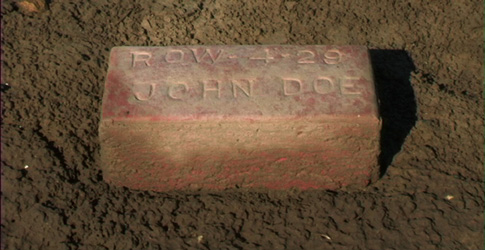Natalia Almada, Stills from Al Otro Lado (To the Other Side), 2005.
Born 1974 in Mexico; lives in Mexico City, Mexico, and New York, New York
Acknowledging six generations of family history in her homeland of Sinaloa, Mexico, filmmaker Natalia Almada honors her heritage by making cross-cultural films that connect the past to the present. As a Mexican-American artist who reflects, as she notes in her director’s statement, on how “free trade with our wealthy neighbor [the U.S.] changed our economy and culture,” Almada is compelled to make portraits of those most aΩected by poverty, not to simply elicit sympathy but to examine the complex nature of decision making under financial duress. Like the ethnographic films of Mongolian writer-director Byambasuren Davaa, Almada’s films expose a culture whose intricacies are largely unknown to their audience, though Almada’s work is purely nonfictional. Her most recent feature, Al Otro Lado (To the Other Side) (2005), decribes corrido music as the artistic imperative that has for two hundred years preserved Mexican tradition, serving as the primary narrative channel through which news of underground culture is spread.
Al Otro Lado juxtaposes three stories by allowing corrido music to serve as narration, replacing the voice-overs typically employed in documentary films. Lyrically, corrido—structurally rooted in medieval troubadour balladry—recounts tales of larger-than-life heroes and outlaws; in recent decades narcocorridos, about drug tra≈ckers, and songs about undocumented immigrants have become popular. Al Otro Lado introduces the story of fourth-generation fisherman Magdiel, a twenty-three-year-old corrido composer who dreams of escaping Sinaloa to the United States in search of musical fame and fortune. Counterbalancing this saga is performance and interview footage of Los Tigres del Norte, an internationally renowned corrido band whose members provide a success model to youth yearning to leave the poverty of Mexico. Interspersed with footage of corrido hero Chalino Sánchez and other corridistas, Al Otro Lado functions in part as music documentary. Scenes shot in Los Angeles and Arizona show how corrido has inspired American fans, as it oΩers a new generation a symbol both of Mexican pride and of an attempt to live the American dream—prefacing Almada’s emphasis on border politics as the story’s underpinning.
One striking aspect of Al Otro Lado is the wealth of candid interview footage Almada captured among drug tra≈ckers, farmers growing marijuana and poppies, “coyotes” who for a fee smuggle Mexicans across the border, members of the U.S. Border Patrol, and Minuteman Civil Defense Corps cofounder Chris Simcox, who finds and detains a group of immigrants hiding in bushes while Almada’s camera is rolling. The film ends as Almada follows a coyote-escorted group, including Magdiel, hoping to make it over the border as night falls. Exploring a world rife with desperation and dreams, Almada’s camera functions as a cinematic corrido, a portrayal of an overarchingly disastrous situation made artistically relevant by her journalistic dedication to its cause. TRINIE DALTON
Natalia Almada, Stills from Al Otro Lado (To the Other Side), 2005. Digital video, color, sound; 66 min. Collection of the artist
























